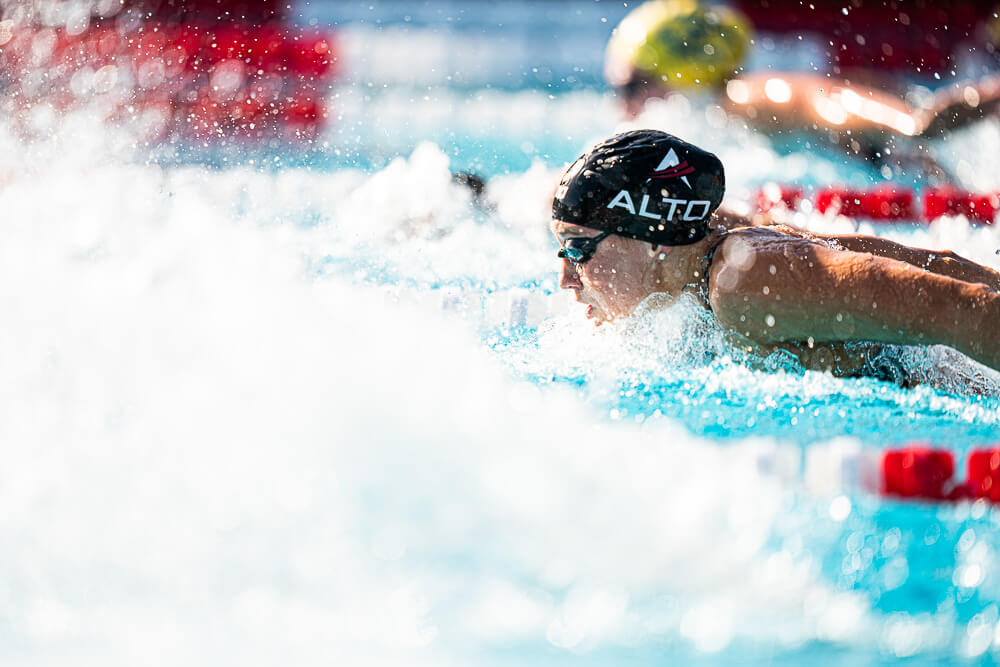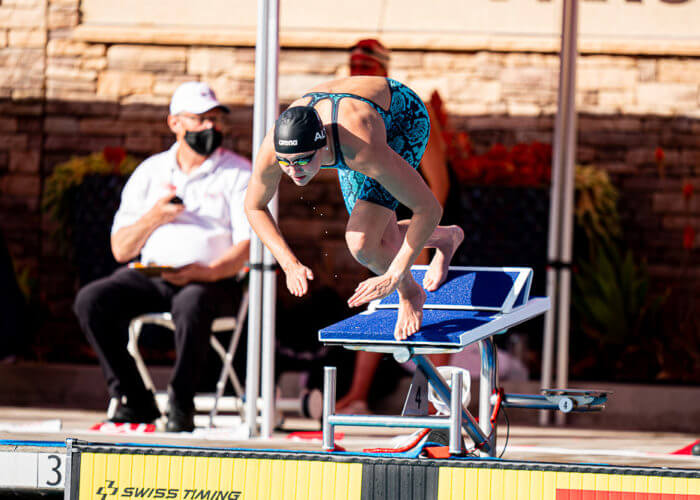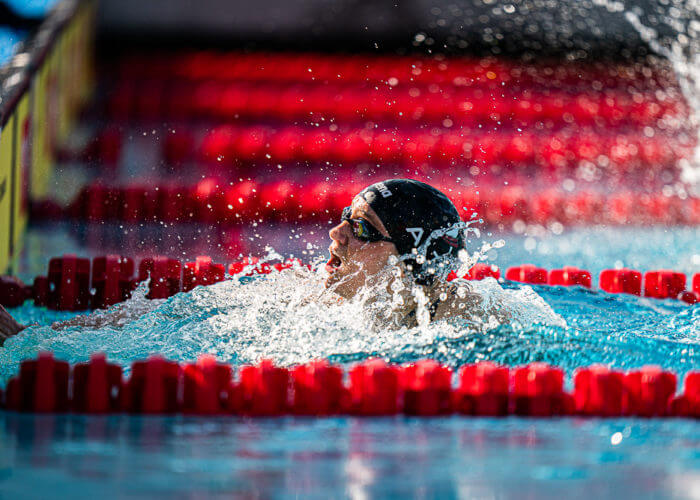Katie Drabot Sees 200 Fly Transform From Proving Greg Meehan Wrong (For Once) to Joining World’s Elite

Katie Drabot Sees 200 Fly Transform From Proving Greg Meehan Wrong (For Once) to Joining World’s Elite
When Katie Drabot learned her final NCAA Championships were canceled, things completely changed.
No longer getting that last swim for her Stanford team, Drabot was now a professional swimmer — something she found out was a huge adjustment, especially the way the COVID-19 pandemic rushed the transition.
“It is the basics — eat, sleep swim. It is focusing everything on swimming. I make sure I do what I need outside the pool to make sure what I do inside the pool is the best it can possibly be,” Drabot told Swimming World. “At times it can be a little lonely, but you just have to think about what you are aiming for.”
Drabot is aiming for a spot on the U.S. Olympic team. She has represented her country at just about every other international meet other than the Olympics — including winning the bronze medal in the 200 butterfly at the 2019 World Championships.
U.S. Trials is the most pressure-packed meet in the country with elite swimmers vying for two spots in most events. That pressure can be useful if harnessed properly.
“There are nerves for sure and there have been all year. I always thing nerves are good. It shows that you care,” Drabot said.
After a year of upheaval, Drabot has put together a solid training block.
“There have been many ups and downs in training this year and trying to get into a good groove again,” she said. “It became the most real when I was back to competing. My first meet in over a year was in San Antonio. I realized I had a lot of work to do. It gave me something to refocus on and see where I was and see what I needed to work on. Meets give great feedback and I got some great feedback. I switched up my training a bit and I feel like I am doing well. I am trying not to think about it too much because that can set off a snowball effect. There is nothing I can do except work hard and be prepared. It is exciting. This is what we have been working toward.”
At Worlds, Drabot began to utilize the nerves in that positive way, gaining confidence with what she had accomplished.
“I think I gained a lot of confidence from worlds, realizing that I have made my presence on the world stage. With that there is confidence, but you never want to be comfortable because in this sport, there is always someone working harder,” she said. “I want to take what I learned from Worlds but it is not given. There is always someone who comes out of nowhere in Trials and makes their presence known. I am going to leave nothing on the table. I know I belong on the world stage, but I need to keep pushing myself to prove I still belong there.”
She also knows that there are plenty of young guns waiting to be unleashed. Drabot said the key is to be aware, but not dwell on how others are swimming.
“You always want to be aware of what people are doing,” she said. “ That is what keeps you going and makes the sport of swimming faster. There is always someone up-and-coming that wants to beat you. But at the same time, you can only control what you are doing. I use the mentality that someone else is training harder than me for that spot. It keeps me going in practice. Trials is such an intense meet and you have to try to get out of your head as much as possible. You have to be confident in what you have accomplished and use it as motivation. The meet is so mental. A good chunk is about the mental preparation.
“It is about trying to keep things as calm as possible. You can’t run from them knocking on the door.”
Drabot has competed at two Olympic Trials in the past, 2012 and 2016, making the semifinals in the 200 free in 2016.
“They were quite a bit different. I was there in 2012 just to be there. I made it the very last meet possible. It was just to gain experience. I finished close to last in the 200 IM,” she said. “I had a few more expectations in 2016, but was there to race at a higher level and see what I could do. I definitely left the meet disappointed with a bitter taste in my mouth. I didn’t expect myself to make the team, but it definitely gave me motivation. With those two meets under my belt, you know what to expect and it gives me a little more confidence.”
Plus, the third time around, Drabot’s main event is the 200 butterfly, an event not on her radar in 2016.
“My focus has shifted to being a butterflyer. I have always dipped my toes in different events. There has never really been that steady event for me throughout my career. My very first state cut was in backstroke and my first junior national cut was in breast. That has helped with my training,” she said.

Katie Drabot. Photo Courtesy: Becca Wyant
But swimming the butterfly at an elite level came during her time at Stanford — and it wasn’t the original plan.
“My freshman year, I came in and I wanted Greg (Meehan) to put me in any events I could help the team out in. That meant the mile the last day of Pac-12s and NCAAs. I did it freshman year and as a sophomore at our goals meeting, I had gotten used to training the butterfly and I felt strong in it. I asked him if I could try out the 200 fly and he looked at me and kind of laughed and wanted to focus on the mile. That really didn’t sit that well with me, but at the same time, I wanted to be a team player and score points wherever I could,” she said. “I kept pushing him on it and the first dual meet that season, he put me in it but I remember coming out of it pretty happy, and he was like, ‘OK, let’s try the 200 fly.’ I did it midseason and it went from there.”
All the way to a bronze medal at Worlds.
“I was happy with it and I felt like I was just stuck in the 200 free and not making improvements. The 200 fly gave me a breath of fresh air. Greg is right 99.9 percent of the time whether I want to admit it or not, but the 200 fly was that 0.01 percent,” she said.
Drabot said training with Hali Flickinger helped her develop her 200 fly race.
“There is so much to be said about Hali. She is a great competitor and just a great human. I get to be in the ready room with her and I have learned a lot from her. She is so consistent and upbeat. She is small but she is feisty. Everyone thinks you need to be this big jacked swimmer but she proves that it doesn’t have to be how it is. She can kill it in a lot of events. I am trying to go in with no fear and adopt her mentality,” Katie Drabot said. “At worlds, swimming next to her helped me.”
It helped validate Drabot’s switch to the 200 fly.
The Pandemic Road
Once her college career was officially over, Drabot had to figure out how to train and where to be. Post-grads were not allowed in college pools at first, and California was one of the strictest states with shutdowns because of the number of COVID-19 cases.
“It was pretty hectic. Right when things hit, I remember one day waking up from a nap to a ton of missed calls and text. One day we were training for NCAAs and the next day we were trying to find a pool. We still had access for a few days, then like everything else, plans quickly changed and post-grads were kicked out. Then other pools closed and we started looking for other opportunities. We probably had five or six different plans all at once,” Drabot said. “It was about making decisions best for us. When there was talk of a total shutdown, I wanted to make a decision that led me to going home with Brooke Forde. I was in Kentucky with her for a couple of weeks. Then their pool got shut down. We quickly resorted to running, biking, anything to stay active. That is when we found out the postponement of trials and the games. That kind of eased the nerves a bit. We didn’t have to be as frantic and we could have a sigh of relief.
“Then we could focus on our health and safety.”

Katie Drabot. Photo Courtesy: Becca Wyant
That changed the venue of her training for a bit.
“We decided it was best for me to come home at that point. I went home to Wisconsin, which was nice because I hadn’t been home that long since I went to college. I got to spend time with my family, got some home-cooked meals and all of the good things of home,” Drabot said. “We had some family friends who had a 12-yard backyard pool. I trained there for a month. It was a lot of resistance training and swimming in place. Just anything to keep moving and keep my feel in the water. Then a pool opened up and we got 4-6 a.m. training. As early as it was, at that point, I wasn’t taking anything for granted. Then Stanford opened back up in July and I made the decision to come back and I have been here ever since.”
And relishing the fact that she is part of that 0.1% where her coach got it wrong, which has worked out pretty well for everyone.



